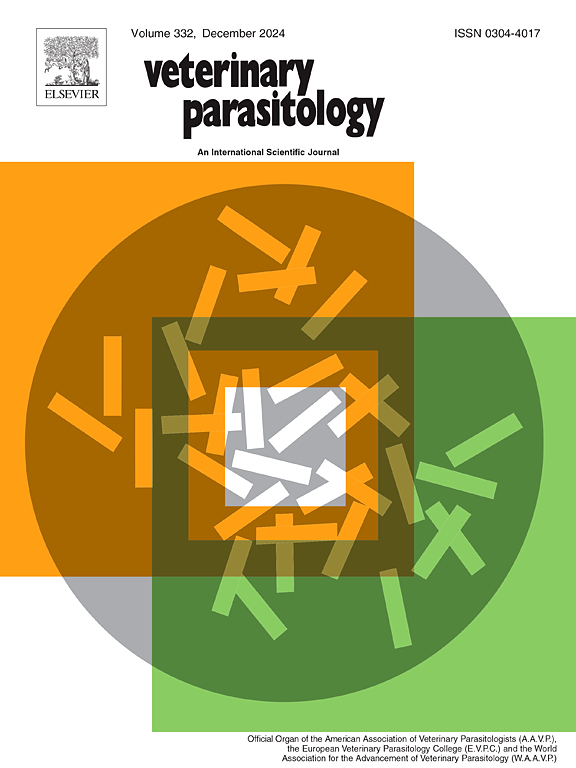Spot-on application of fluralaner on cats produces high mortality in pyrethroid-resistant and susceptible Triatoma infestans, in comparison with spinosad and imidacloprid
IF 2.2
2区 农林科学
Q2 PARASITOLOGY
引用次数: 0
Abstract
Pyrethroid resistance is an increasing threat to vector control programs worldwide. Triatomines, the vectors of Chagas disease are also exhibiting resistant phenotypes. In the Gran Chaco region the increasing emergence of pyrethroid-resistant Triatoma infestans populations calls for renewed efforts in search of alternative tools that could complement traditional vector control activities based on insecticide spraying. With this intention, we evaluated the efficacy of three commercially available ectoparasiticides for veterinarian use in cats: fluralaner (Bravecto®), imidacloprid (Power Met®) and spinosad (Power®), on the mortality of pyrethroid-resistant and -susceptible T. infestans. The trial included 25 domestic, owned cats, randomly assigned to one of the three treatments or two control groups. Bioassays were performed at 0, 4, 30 and 60 days post-treatment (DPT) and consisted in exposing groups of laboratory-reared third to fifth-instar nymphs to each cat. Kaplan-Meier curves showed a significant reduction of survival probability in the triatomines exposed to cats treated with fluralaner and spinosad comparing with their respective controls whereas no lethal effects were observed in the imidacloprid-treated group. In fluralaner-treated cats, triatomines exhibited 80 %, 54 % and 29 % of mortality at 4, 30 and 60 DPT, respectively; whereas in spinosad-treated cats, triatomines achieved 56 % and 37 % of mortality at 4 and 30 DPT, respectively. No significant effect of triatomines pyrethroid-susceptibility status was observed. Given the higher mortality levels achieved and longer lethal effect, our results support the evaluation of cat treatment with fluralaner in a Phase II trial to cope with current challenges of vector control like pyrethroid-resistance.
与spinosad和吡虫啉相比,氟拉烷在猫身上的现场应用对拟除虫菊酯产生抗性和易感的感染三角瘤致死率很高
拟除虫菊酯类杀虫剂抗药性对全世界病媒控制规划构成日益严重的威胁。恰加斯病的病媒锥蝽也表现出耐药表型。在大查科地区,对拟除虫菊酯类杀虫剂有抗药性的红眼虫种群日益增多,要求重新努力寻找可补充以喷洒杀虫剂为基础的传统病媒控制活动的替代工具。为此,我们评估了三种市售的兽医用猫除虫剂:氟拉烷(Bravecto®)、吡虫啉(Power Met®)和spinosad (Power®)对拟除虫菊酯耐药和敏感的感染T.致死率的影响。试验包括25只家猫,随机分配到三种治疗组之一或两个对照组。在治疗后0,4,30和60天(DPT)进行生物测定,包括将实验室饲养的3至5龄若虫组暴露于每只猫。Kaplan-Meier曲线显示,与各自的对照组相比,暴露于氟拉烷和spinosad治疗猫的triatomines存活率显著降低,而吡虫啉治疗组没有观察到致死效应。在氟拉烷治疗的猫中,三聚氰胺在DPT 4,30和60时的死亡率分别为80 %,54 %和29 %;而在经spinosad治疗的猫中,三聚氰胺在4次和30次DPT时的死亡率分别为56% %和37% %。对拟除虫菊酯类药物易感状态无明显影响。鉴于更高的死亡率和更长的致死效果,我们的研究结果支持在II期试验中对氟拉烷治疗猫的评估,以应对目前媒介控制的挑战,如拟除虫菊酯耐药性。
本文章由计算机程序翻译,如有差异,请以英文原文为准。
求助全文
约1分钟内获得全文
求助全文
来源期刊

Veterinary parasitology
农林科学-寄生虫学
CiteScore
5.30
自引率
7.70%
发文量
126
审稿时长
36 days
期刊介绍:
The journal Veterinary Parasitology has an open access mirror journal,Veterinary Parasitology: X, sharing the same aims and scope, editorial team, submission system and rigorous peer review.
This journal is concerned with those aspects of helminthology, protozoology and entomology which are of interest to animal health investigators, veterinary practitioners and others with a special interest in parasitology. Papers of the highest quality dealing with all aspects of disease prevention, pathology, treatment, epidemiology, and control of parasites in all domesticated animals, fall within the scope of the journal. Papers of geographically limited (local) interest which are not of interest to an international audience will not be accepted. Authors who submit papers based on local data will need to indicate why their paper is relevant to a broader readership.
Parasitological studies on laboratory animals fall within the scope of the journal only if they provide a reasonably close model of a disease of domestic animals. Additionally the journal will consider papers relating to wildlife species where they may act as disease reservoirs to domestic animals, or as a zoonotic reservoir. Case studies considered to be unique or of specific interest to the journal, will also be considered on occasions at the Editors'' discretion. Papers dealing exclusively with the taxonomy of parasites do not fall within the scope of the journal.
 求助内容:
求助内容: 应助结果提醒方式:
应助结果提醒方式:


